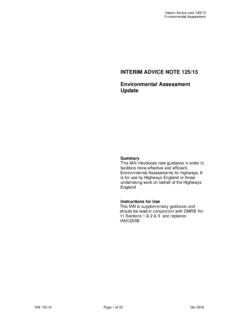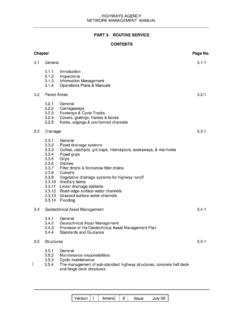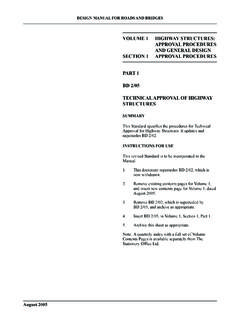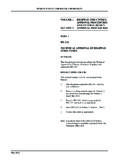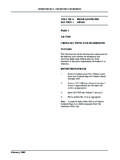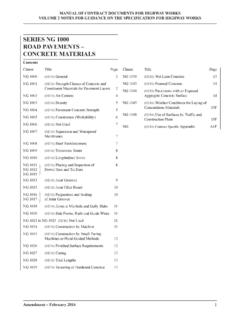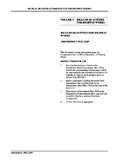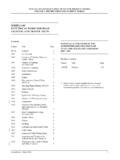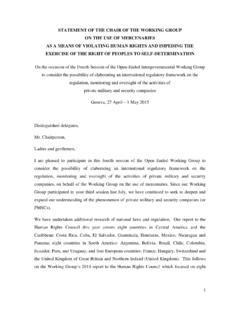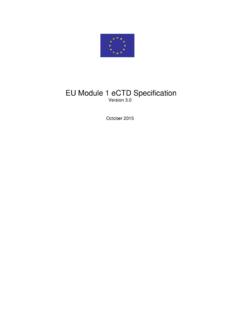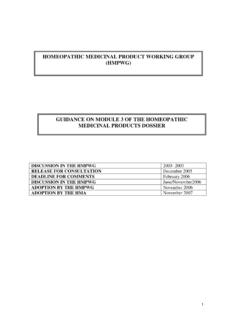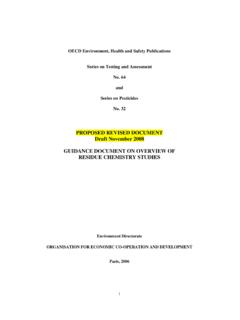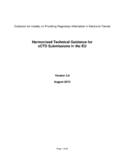Transcription of HD 26/06 - PAVEMENT DESIGN - Standards for Highways
1 February 2006 DESIGN MANUAL FOR ROADS AND BRIDGESVOLUME 7 PAVEMENT DESIGN ANDMAINTENANCESECTION 2 PAVEMENT DESIGN ANDCONSTRUCTIONPART 3HD 26/06 PAVEMENT DESIGNSUMMARYThis Standard provides the details of permittedmaterials and of thickness for the construction ofpavements for new trunk roads. This revision updatesthe previous Standard and also introduces differentpermitted designs that relate to the strength of theavailable FOR Contents pages from Volume 7 andinsert new Contents pages for Volume 7 datedFebruary HD 26/01 from Volume 7, Section 2which is superseded by this Standard and archiveas HD 26/06 into Volume 7, Section archive this sheet as : A quarterly index with a full set of VolumeContents Pages is available separately from TheStationery Office 26/06 PAVEMENT DesignSummary.
2 This Standard provides the details of permitted materials and of thickness forthe construction of pavements for new trunk roads. This revision updates theprevious Standard and also introduces different permitted designs that relate tothe strength of the available MANUAL FOR ROADS AND BRIDGESTHE Highways AGENCYSCOTTISH EXECUTIVEWELSH ASSEMBLY GOVERNMENTLLYWODRAETH CYNULLIAD CYMRUTHE DEPARTMENT FOR REGIONAL DEVELOPMENTNORTHERN IRELANDV olume 7 Section 2 Part 3 HD 26/06 February 2006 REGISTRATION OF AMENDMENTSA mendPage NoSignature & Date ofAmendPage NoSignature & Date ofNoincorporation ofNoincorporation ofamendmentsamendmentsRegistration of AmendmentsVolume 7 Section 2 Part 3 HD 26/06 February 2006 REGISTRATION OF
3 AMENDMENTSA mendPage NoSignature & Date ofAmendPage NoSignature & Date ofNoincorporation ofNoincorporation ofamendmentsamendmentsRegistration of AmendmentsVOLUME 7 PAVEMENT DESIGN ANDMAINTENANCESECTION 2 PAVEMENT DESIGN ANDCONSTRUCTIONPART 3HD 26/06 PAVEMENT DESIGN and MANUAL FOR ROADS AND BRIDGESF ebruary 2006 Volume 7 Section 2 Part 3 HD 26/06 February 20061/1 Chapter 1 Introduction1. INTRODUCTIONM andatory of this document which form partof the Standards of the Overseeing Organisationsare highlighted by being contained in boxes. Theseare the sections with which the DesignOrganisations must comply, or must have agreed asuitable departure from Standard with the relevantOverseeing Organisation.
4 The remainder of thedocument contains advice and enlargement whichis commended to DESIGN Organisations for part details various combinations ofmaterials and thicknesses that may be considered forpavement construction, whether for new build,widening of an existing carriageway, or fullreconstruction. The DESIGN guidance is also useful whendeveloping recommendations for partial reconstructionor strengthening overlays when used together with theinvestigation techniques described in HD 30 ( ). It does not include the estimation of designtraffic (see HD 24, DMRB ), nor does it cover thedesign of PAVEMENT foundations (see HD 25, ).
5 Additional information on surfacing andpavement materials is given in HD 36 and HD 37(DMRB ). 2 sets down the philosophy behind theStandard Designs and summarises the alternatives in theform of nomographs or equations. Chapter 3 providesadditional information on material behaviour to assistthe designer. Chapter 4 discusses analytical proceduresand material properties, which may be used by thedesigner to produce Alternative Designs or developpartial reconstruction and strengthening Part must be used forthwith on allschemes for the construction, improvement andmaintenance of trunk roads including motorwayscurrently being prepared, provided that, in theopinion of the Overseeing Organisation this wouldnot result in significant additional expense ordelay.
6 DESIGN Organisations must confirm itsapplication to particular schemes with theOverseeing in Northern use in Northern Ireland, this Standardwill apply to those roads designated by theOverseeing construction and maintenance ofhighway pavements will normally be carried outunder contracts incorporating the OverseeingOrganisations Specification for Highway Works(SHW) which are contained in the Manual ofContract Documents for Highway Works Volume 1(MCHW 1). In such cases products conforming toequivalent Standards and specification of otherMember States (MS) of the European EconomicArea (EEA) or a State which is party to a relevantagreement with the European Union and testsundertaken in other MS of the EEA or a Statewhich is party to a relevant agreement with theEuropean Union will be acceptable in accordancewith the terms of Clauses 104 and 105 ( ).
7 Any contract not containing these Clausesmust contain suitable clauses of mutual recognitionhaving the same effect, regarding which adviceshould be 7 Section 2 Part 3 HD 26/06 February 20062/1 Chapter 2 Standard Designs2. STANDARD DESIGNSDESIGN designs given in this Part are based on TRLR eport 615 (2004) for flexible construction (includingpavements previously known as flexible composite);TRL Report 630 (2005) for rigid (continuous)construction; and TRL Report RR87 (1987) for rigid(jointed) adoption of the material specific calibrationadjustment factors recommended in TRL Report 615(2004) will give PAVEMENT designs using traditionalmaterials that are in close agreement with the previousflexible and flexible composite designs, which werebased on TRL Report LR1132 (1984).
8 Standard designs for HMB35 have beenremoved, but designs for an Enrobe a Module Eleve(EME2) material based on French practice has beenadded. The DESIGN thickness lines for DBM50 andHDM50 have been combined, based on pastperformance of these two almost identical materials. InScotland, HMB 35 is also permitted using the samedesign thickness as shown for DBM50/HDM50 CRC designs now include a wider choice ofconcrete strength and foundation classes thanpreviously. The DESIGN philosophy continues to bebased on TRL Report RR87 (1987). thicknesses are based on four foundationstiffness classes, defined as the equivalent half-spacelong-term stiffness of the composite foundation underthe completed PAVEMENT , as follows: Foundation Class 1 50 MPa; Foundation Class 2 100 MPa; Foundation Class 3 200 MPa; Foundation Class 4 400 should be noted that the stiffness values givenin any performance related Specification will differfrom the above, since any in situ tests measure the earlyage and with the materials in different Class 1 is a capping only DESIGN ,in accordance with HD 25 (DMRB ) withouta subbase layer.
9 This foundation must not be usedfor DESIGN traffic in excess of 20 million standardaxles (msa) without a Departure from Standard from the Overseeing Class 2 is either a subbase andcapping DESIGN , or a subbase only DESIGN , inaccordance with HD 25 (DMRB ). Thisfoundation must not be used for DESIGN traffic inexcess of 80 msa, unless 150mm or more of abound subbase is used, without a Departure fromStandard from the Overseeing Classes 3 and 4 are designs typicallyincorporating Cement or other Hydraulically BoundMixtures (collectively referred to as HBM in this Part).Refer to Chapter 3 for further details on For new road DESIGN , all lanes, including thehardshoulder, must be constructed to carry thedesign traffic in the heaviest loaded lane,commonly the left hand lane, as calculated inHD 24 (DMRB ).
10 For maintenance DESIGN , each lane would, as aminimum, be strengthened/reconstructed to carry thedesign traffic for that particular lane. However, thedesign must ensure continuity of drainage, both in andbelow the PAVEMENT layers and across the For motorway widening the requirements of theOverseeing Organisation will depend on the specificproject, and will take account of a range of constraints,including technical, operational and financial. Also seeHD 27 (DMRB ). The minimum DESIGN traffic for lightly traffickedtrunk roads should be 1msa as set out in HD 24 ( ).Flexible For trunk roads up to 30 msa, it may beadvantageous to use cold recycled materials and adesign guide is available as part of TRL Report 611(2004).
